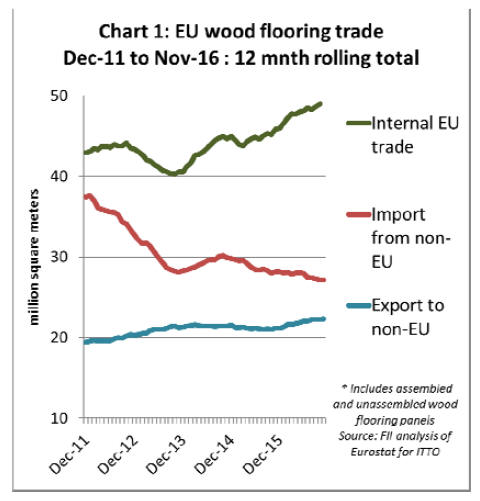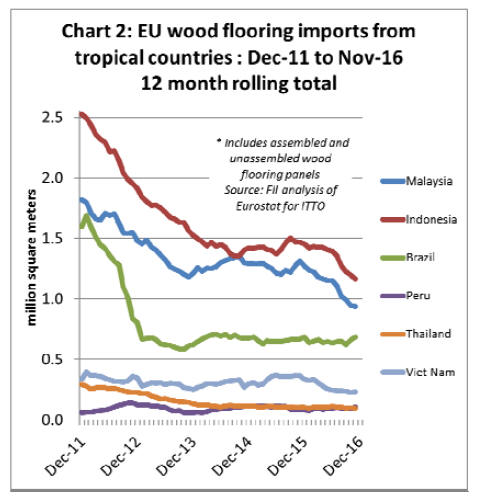|
Report from
Europe
German trade shows highlight intensity of competition
The European trade show season is now well underway,
starting in Germany during January with the Domotex
flooring show in Hanover and the IMM furniture show in
Cologne. The shows provided good insights into European
wood market prospects in the year ahead.
The shows in Germany have become increasingly
influential over the years as the centre of European wood
manufacturing has shifted from southern and western
countries to northern and eastern countries and because
German industry has built a formidable reputation as a
leading innovator in the wood products and other material
sectors.
Both shows highlighted that there are now significant
obstacles to tropical wood suppliers looking to increase
market share in the European market. This is a market
characterised by a rising number of suppliers offering an
increasing variety of products chasing demand which is
growing only slowly.
Wood continues to come under intense pressure from nonwood
materials. Where wood is preferred, domestic
manufacturers are very dominant, with a strong preference
for local species (particularly oak which accounts for
nearly 80% of European real wood flooring production).
On the other hand, the shows also highlight underlying
trends in the European market with potential to offer
significant new opportunities to manufacturers of wood
products in the tropics.
The desire for products which are ¡°natural¡±, ¡°authentic¡±
and ¡°individual¡±, and which are backed by a strong
¡°narrative¡± could be turned to the advantage of tropical
wood suppliers and manufacturers.
While oak remains dominant, European buyers and
manufacturers are constantly on the look-out for
something new and different to give a market edge.
EU flooring manufacturers increase market share
The trade background to the Domotex 2017 flooring show
held in Hanover between 12 and 15 January is shown in
Chart 1 which indicates that internal EU trade in wood
flooring has been rising continuously since December
2013.
This is due partly to improving consumption of wood
flooring products manufactured in the EU, and to the
increasing role of manufacturing facilities in lower cost
Eastern European countries to supply wood flooring to
other parts of the EU.

Meanwhile, the EU¡¯s large trade deficit in wood flooring
that opened up before the financial crises, driven by the
housing bubble and a flood of product from Asia, has
narrowed sharply in recent years.
Efforts by European manufacturers to improve
competitiveness through innovation in products and
marketing, aided by the relative weakness of the euro and
other European currencies compared to the US dollar,
contributed to rising EU exports of wood flooring products
to other parts of the world last year.
At the same time imports from outside the EU continued
to decline in 2016. Much of the decline in EU wood
flooring imports is due to falling trade with China, by far
the largest external supplier accounting for around 60% of
total EU imports.
EU imports of wood flooring from China were around 16
million sq.m in the 12 months to end November 2016,
compared to 17.4 million sq.m a year earlier and over 21
million sq.m in 2012.

EU imports of wood flooring from tropical countries have
also been declining in recent years (Chart 2). Imports from
Indonesia in the 12 months to November 2016 were 1.16
million sq.m compared to 1.45 million sq.m a year earlier.
Imports from Malaysia fell from 1.31 million sq.m to 0.94
million sq.m during the same period.
The data is particularly significant from an Indonesian
perspective. The figures to the end of November represent
the real baseline against which the immediate impact of
the FLEGT licensing system can be judged.
The first FLEGT licenses were issued in the middle of
November and it will be interesting to monitor whether the
recent slide in EU wood flooring imports from Indonesia
can be reversed.
Considerable growth in DOMOTEX visitor numbers
The intense and rising competitiveness of the European
flooring sector is immediately apparent from the
DOMOTEX 2017 show numbers which hosted 1409
exhibitors from more than 60 countries.
The show was notable for considerable growth in the
number of exhibitors this year and the total amount of
space booked, and with an even higher percentage of
exhibitors and visitors from abroad compared to previous
shows.
Around 70% of DOMOTEX visitors this year were from
outside Germany, with the majority (43%) coming from
other EU countries. Total visitor numbers were slightly
down on previous years, but there was a significant
increase in visitors from the Near and Middle East (up
9%) as well as East and Central Asia (up 16%).
Appreciably more visitors also came from the U.S. and the
UK.
An insight into potentially significant innovations in the
European flooring sector was provided by the prestigious
Innovations@DOMOTEX display selected from products
on show by a jury of experts from the fields of design,
architecture, the media and interior design. Their choices
implied strong interest in sustainable design and a
preference for products with a natural look and feel, whose
textures, materials, motifs and surfaces take their cues
from nature.
Sustainability a strong theme in flooring design
Sustainability was a strong theme in the wider show, with
more wood flooring manufacturers communicating the
origins of the woods they use through forest certification
and other mechanisms.
Manufacturers of flooring in other materials were also
exploiting the green image of wood. There was a very
strong presence of laminate and designer flooring with
surfaces of such deceptively natural appearance that they
can hardly be discerned from real wood. Even the
carpeting sector was seeking to convey an environmental
message through use of designs imitating tree bark and
other natural surfaces.
As in previous years, the wood flooring on display at
DOMOTEX 2017 was heavily oriented towards oak which
was presented in a wide variety of colours, textures and
finishes.
However, some manufacturers were looking to
differentiate from competitors by offering new types of
wood. Particularly encouraging for the tropical wood
sector was that two Peruvian flooring suppliers featured in
the Innovations@DOMOTEX display.
Peruvian flooring manufacturers make an impact
DOMOTEX show publicity highlighted the strong
sustainability credentials of the two Peruvian companies,
Amaz Floors and Maderera R¨ªo Acre.
It notes that all their wood derives from FSC certified
forests in Peru and that the companies also guarantee
emissions reductions from degradation and deforestation
(REDD) through VCS and CCB standards. Species on
offer, such as Cumaru, Balsamo, Jatoba, Massaranduba,
and Garapa, are still not widely used or known in the
European flooring and decking sectors.
The DOMOTEX show publicity for Amaz floors also
celebrated and made a virtue of ¡°the patched-up knotholes
and uneven surfaces which create the raw aesthetic
of ¡®Antique Rustic Decking¡¯¡± and the fact that the
¡°tropical wood is worked manually in the country of
origin, with the aim of securing jobs there¡±.
In the case of Maderera R¨ªo Acre, the emphasis was on
their "Munay Deck" product ¡°manufactured from small
wooden strips, which form an intriguingly structured
surface and would otherwise end up as waste¡±.
Efforts such as these to introduce new timber species to
the European flooring market were the exception rather
than the rule, and most exhibitors were using other
techniques to extend the look and feel of products.
Exhibitors were more likely to create interesting visual
effects by combining diverse colours, patterns, shapes and
textures. There was a strong focus this year on longer and
wider dimensions and on herringbone-patterned flooring.
Shades of grey and textured services
Trend-spotters believe that grey or blends of grey and
beige ¨C "greige" ¨C will remain the top sellers, while dark
floorings are less popular with buyers. Textured surfaces
are seen as ¡°the next big thing¡± in wood and parquet
flooring. There were a lot of "used" and grainy patterns
and finishes on display - floorings designed to look
brushed and often made from of reclaimed materials.
Vintage-look materials remain in fashion, along with knot
holes, core splits and even traces of the saw blade or flakes
of cement. This is true both of natural wood flooring and
laminated wood flooring sector, the latter now exploiting
increasingly sophisticated digital printing technology.
Various innovations were on display to improve service
life of wood flooring in rooms such as kitchens and
bathrooms where wood has not traditionally been widely
used.
For example French manufacturer Design Parquet was
promoting their patented Navylam+ system comprising
strips of tropical wood, favoured both for its look and
natural durability, which are pre-oiled and with an
integrated jointing system.
Another highly innovative product designed to extend
wood¡¯s range of applications even further was
"Lambdafloor" by Poland's Prestige which boasts an
aluminum layer between the wooden surface and the
water-repellent base material, in this way augmenting the
thermal conductivity for use with underfloor heating
systems.
DOMOTEX 2017 highlighted that increasingly flexible
and modular wood flooring products continue to be
developed that are easier and less time-consuming to
install and maintain, solvent free, better for indoor air
quality and personal health and hygiene, and which offer
other benefits in terms of durability and improved footfall
dampening.
|